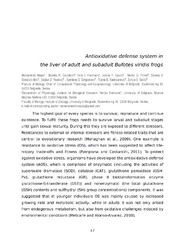Приказ основних података о документу
Antioxidative defense system in liver of adult and subadult Bufotes viridis frogs
| dc.creator | Nasia, Mohammed | |
| dc.creator | Gavrilović, Branka | |
| dc.creator | Krizmanić, Imre | |
| dc.creator | Gavrić, Jelena | |
| dc.creator | Prokić, Marko | |
| dc.creator | Borković Mitić, Slavica | |
| dc.creator | Pavlović, Slađan | |
| dc.creator | Despotović, Svetlana | |
| dc.creator | Radovanović, Tijana | |
| dc.creator | Saičić, Zorica | |
| dc.date.accessioned | 2019-07-12T08:15:32Z | |
| dc.date.available | 2019-07-12T08:15:32Z | |
| dc.date.issued | 2017 | |
| dc.identifier.uri | https://radar.ibiss.bg.ac.rs/handle/123456789/3421 | |
| dc.description.abstract | The highest goal of every species is to survival, reproduce and continue existence. To fulfill these frogs needs to survive larval and subadult stages until gain sexual maturity. During this they are exposed to different stressors. Resistances to external or internal stressors are fitness-related traits that are central to evolutionary research (Monaghan et al., 2009). One example is resistance to oxidative stress (OS), which has been suggested to affect lifehistory trade-offs and fitness (Pamplona and Costantini, 2011). To protect against oxidative stress, organisms have developed the antioxidative defense system (AOS), which is comprised of enzymatic (including the activities of superoxide dismutase (SOD), catalase (CAT), glutathione peroxidase (GSHPx), glutathione reductase (GR), phase II biotransformation enzyme glutathione-S-transferase (GST)) and nonenzymatic (the total glutathione (GSH) contents and sulfhydryl (SH) group concentrations) components. It was suggested that in younger individuals OS was mainly caused by increased growing rate and metabolic activity, while in adults it was not only arised from endogenous metabolism, but also from oxidative challenges induced by environmental conditions (Metcalfe and Alonso-Alvarez, 2010). In this study we tried to examine AOS of liver of subadult and adult Bufotes viridis frogs caught from natural population and kept in laboratory conditions for 14 days, in order to determine possible differences in AOS that could be related to the frog’s body size and life stage (adults and subadults). The results showed higher activities of SOD, GR and GST in subadults in comparison to adults, on the other hand adults had higher activity of GSH-Px and concentrations of GSH and SH- groups. CAT was the only parameter that did not differ significantly between groups and did not correlate with frog’s snout-vent length (SVL). Significant negative correlations were noticed between frogs SVL and activity of SOD (r=-0.69) and GST (r=-0.45), while positive correlations of SVL were with GSH-Px (r=0.63), GSH (r=0.67) and SH groups (r=0.52). Based on the results we conclude that in subadults enzymatic components of AOS (SOD, GR and GST) played most important role in response to OS, while in adults it were nonenzimatic components (GSH and SH) that were already marked as biomarkers of some xenobiotics that tend to accumulate. | en |
| dc.language.iso | en | sr |
| dc.publisher | Association of Naturalists Students of the Jagiellonian University | sr |
| dc.rights | openAccess | sr |
| dc.source | Conference of young evolutionary biologist: Abstract Book. Krakow, Poland; 02-04, June 2017 | sr |
| dc.title | Antioxidative defense system in liver of adult and subadult Bufotes viridis frogs | en |
| dc.type | conferenceObject | sr |
| dc.rights.license | ARR | sr |
| dcterms.abstract | Радовановић, Тијана; Деспотовић, Светлана; Павловић, Слађан; Насиа, Мохаммед; Гавриловић, Бранка; Кризманић, Имре; Борковић-Митић, Славица; Гаврић, Јелена; Прокић, Марко; Саичић, Зорица; | |
| dc.rights.holder | Association of Naturalists Students of the Jagiellonian University | sr |
| dc.citation.spage | 47 | |
| dc.citation.epage | 48 | |
| dc.type.version | publishedVersion | sr |
| dc.identifier.fulltext | https://radar.ibiss.bg.ac.rs//bitstream/id/5246/Conference-of-young-evolutionary-biologists-2017-47-48.pdf | |
| dc.identifier.rcub | https://hdl.handle.net/21.15107/rcub_ibiss_3421 |

